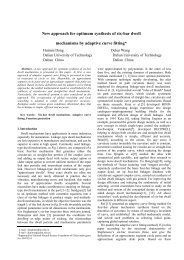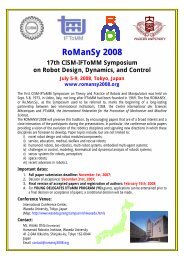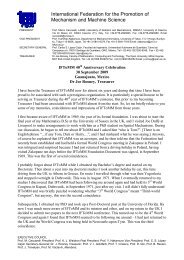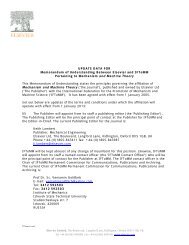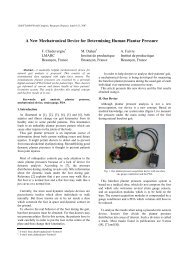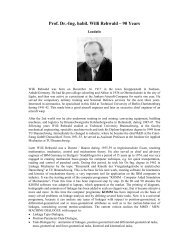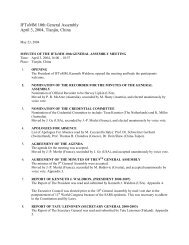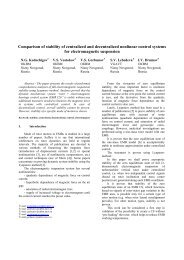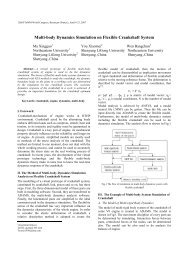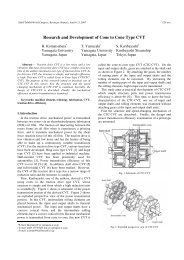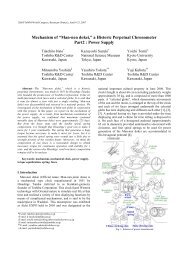A simple technique for measuring the base helix angle of ... - IFToMM
A simple technique for measuring the base helix angle of ... - IFToMM
A simple technique for measuring the base helix angle of ... - IFToMM
Create successful ePaper yourself
Turn your PDF publications into a flip-book with our unique Google optimized e-Paper software.
12th <strong>IFToMM</strong> World Congress, Besançon, June 18-21, 2007 406<br />
cutter that is potentially able to generate <strong>the</strong> gear ([8])<br />
p<br />
= π m cosα<br />
(30)<br />
bn n n<br />
Quantities m n and α n appearing in Eq. (30) are, as is<br />
known, <strong>the</strong> module and <strong>the</strong> pressure <strong>angle</strong> <strong>of</strong> <strong>the</strong> rack<br />
cutter. Despite <strong>the</strong> existence <strong>of</strong> infinite pairs <strong>of</strong> values <strong>for</strong><br />
m n and α n that satisfy Eq. (30), <strong>the</strong>re is <strong>the</strong> chance that <strong>the</strong><br />
inspected gear has been obtained by a cutter that has<br />
normalized dimensions. Should this be <strong>the</strong> case, m n and α n<br />
can be identified after a few attempts (generally is α n =20°,<br />
less frequently-used values being 14.5°, 15°, 17°, 22.5°,<br />
25°, and 30°; <strong>the</strong> series <strong>of</strong> normalized values <strong>of</strong> m n is<br />
traceable in standardization tables [10]).<br />
Once m n and α n have been singled out, it is possible to<br />
complement <strong>the</strong> auxiliary in<strong>for</strong>mation on <strong>the</strong> inspected<br />
gear by computing <strong>the</strong> two setting parameters <strong>of</strong> <strong>the</strong> rack<br />
cutter with respect to <strong>the</strong> gear, namely, <strong>the</strong> cutting <strong>helix</strong><br />
<strong>angle</strong> β and <strong>the</strong> pr<strong>of</strong>ile shift x. The <strong>for</strong>mer is <strong>the</strong> <strong>angle</strong><br />
between <strong>the</strong> generators <strong>of</strong> <strong>the</strong> teeth <strong>of</strong> <strong>the</strong> rack cutter and<br />
<strong>the</strong> axis <strong>of</strong> <strong>the</strong> gear, whereas <strong>the</strong> latter is <strong>the</strong> distance (with<br />
sign) between two parallel planes fixed to <strong>the</strong> rack cutter:<br />
one is <strong>the</strong> reference plane <strong>of</strong> <strong>the</strong> rack (i.e., <strong>the</strong> plane on<br />
which <strong>the</strong> thickness <strong>of</strong> <strong>the</strong> rack teeth matches <strong>the</strong> width <strong>of</strong><br />
<strong>the</strong> rack tooth spaces), whereas <strong>the</strong> o<strong>the</strong>r is <strong>the</strong> plane that<br />
rolls − while <strong>the</strong> gear is being generated by <strong>the</strong> rack cutter<br />
− on an ideal cylinder coaxial with <strong>the</strong> gear.<br />
Angle β is implicitly given by ([8])<br />
sin βb<br />
sin β = (31)<br />
cosα<br />
The pr<strong>of</strong>ile shift x can be obtained by ([8])<br />
sbn<br />
⎛ π ⎞<br />
− m cosα<br />
⎜ + z invα<br />
⎟<br />
cos βb<br />
⎝ 2 ⎠<br />
x = (32)<br />
2 sinα<br />
where m (<strong>the</strong> transverse module) and α (<strong>the</strong> so-called<br />
transverse pressure <strong>angle</strong>) are given by ([8])<br />
m n<br />
n<br />
m = (33)<br />
cos β<br />
sinαn<br />
sinα<br />
= (34)<br />
cos β<br />
b<br />
At this point it is left to <strong>the</strong> reader <strong>the</strong> final choice on<br />
whe<strong>the</strong>r to identify a helical involute gear by four<br />
parameters (z, ρ, β b , s bn ) or five parameters (z, m n , α n , β,<br />
x). In favor <strong>of</strong> <strong>the</strong> four-parameter choice is <strong>the</strong> one-to-one<br />
correspondence between sets <strong>of</strong> parameters and gears,<br />
whereas infinitely-many five-parameter sets identify <strong>the</strong><br />
same gear. The only real advantage <strong>of</strong> <strong>the</strong> five-parameter<br />
choice is <strong>the</strong> explicit reference to <strong>the</strong> geometry and setting<br />
<strong>of</strong> a rack cutter by which <strong>the</strong> gear can be obtained.<br />
Although such a rack cutter is one out <strong>of</strong> <strong>the</strong> infinitelymany<br />
that are apt to generate <strong>the</strong> gear, most frequently it<br />
is also <strong>the</strong> only one characterized by normalized values <strong>of</strong><br />
m n and α n .<br />
B. Accuracy issues and limitations<br />
The three <strong>technique</strong>s described in section III all lay on<br />
rigorous grounds and would result in <strong>the</strong> same outcome if<br />
applied to a perfect helical involute gear. Despite this, in<br />
practice <strong>the</strong> accuracy <strong>of</strong> <strong>the</strong>ir results tends to decrease<br />
from <strong>the</strong> first to <strong>the</strong> third <strong>technique</strong>. The reason is mainly<br />
due to potential ill-conditioning <strong>of</strong> <strong>the</strong> set <strong>of</strong> equations to<br />
be solved: if two overpin measurements <strong>of</strong> <strong>the</strong> same gear<br />
were executed with two pairs <strong>of</strong> pins whose diameters<br />
differs only slightly, <strong>the</strong> minuscule geometric difference<br />
detectable, in principle, by <strong>the</strong> two measurements would<br />
be almost completely masked by <strong>the</strong> finite accuracy that<br />
affects <strong>the</strong> adopted <strong>measuring</strong> instrument, so that<br />
inaccurate results would be obtained. There<strong>for</strong>e, if two or<br />
more overpin measurements <strong>of</strong> a gear are required, care<br />
must be paid in selecting as far apart from each o<strong>the</strong>r as<br />
possible <strong>the</strong> diameters <strong>of</strong> different pairs <strong>of</strong> pins, still<br />
preserving <strong>the</strong> correct contact between <strong>the</strong> pins and <strong>the</strong><br />
portion <strong>of</strong> involute helicoids on <strong>the</strong> tooth flanks (to this<br />
end, <strong>the</strong> pins with <strong>the</strong> smallest diameter could be flattened<br />
in order to make <strong>the</strong>m reach <strong>the</strong> inner part <strong>of</strong> <strong>the</strong> involute<br />
helicoids while avoiding contact with <strong>the</strong> root cylinder <strong>of</strong><br />
<strong>the</strong> gear). As a rule, if more than one <strong>technique</strong> is<br />
applicable to <strong>the</strong> case at hand, preference should be<br />
granted to <strong>the</strong> <strong>technique</strong> that requires <strong>the</strong> lowest number<br />
<strong>of</strong> overpin measurements.<br />
All three methods described in <strong>the</strong> previous section are<br />
expected to show a declining accuracy as <strong>the</strong> <strong>base</strong> <strong>helix</strong><br />
<strong>angle</strong> β b approaches zero. Should this occur, a small error<br />
affecting <strong>the</strong> argument <strong>of</strong> <strong>the</strong> cos −1 function on <strong>the</strong> righthand<br />
side <strong>of</strong> Eq. (15) would translate into a great<br />
uncertainty about <strong>the</strong> cos −1 value. Fortunately, involute<br />
helical gears that are almost spur gears are quite<br />
uncommon, and <strong>the</strong> limitation just outlined is seldom<br />
relevant.<br />
In any case, even in <strong>the</strong> most favousable conditions, <strong>the</strong><br />
accuracy associated to <strong>the</strong> value <strong>of</strong> β b assessed by any <strong>of</strong><br />
<strong>the</strong> explained procedures is no match <strong>for</strong> <strong>the</strong> higher<br />
accuracy attainable by state-<strong>of</strong>-<strong>the</strong>-art gear inspection<br />
apparatuses. These are equipped with <strong>measuring</strong> devices<br />
that are more precise than 0.01 mm-accurate micrometers,<br />
and can make <strong>the</strong>ir feeler run along <strong>the</strong> full span L <strong>of</strong> <strong>the</strong><br />
gear width in order to accurately determine <strong>the</strong> lead <strong>of</strong> <strong>the</strong><br />
helicoidal tooth flanks. Never<strong>the</strong>less <strong>the</strong> proposed<br />
inspection method proves valuable whenever special<br />
checking equipment is unavailable or unjustified.<br />
The three <strong>technique</strong>s dealt with in this paper are not<br />
applicable to spur gears (β b = 0). In case <strong>the</strong> radius ρ <strong>of</strong><br />
<strong>the</strong> <strong>base</strong> cylinder and <strong>the</strong> <strong>base</strong> tooth thickness s b <strong>of</strong> a spur<br />
gear have to be assessed, <strong>the</strong> three presented <strong>technique</strong>s<br />
should be modified so as to drop one overpin<br />
measurement from each <strong>of</strong> <strong>the</strong>m. For instance, <strong>the</strong> three<br />
5



